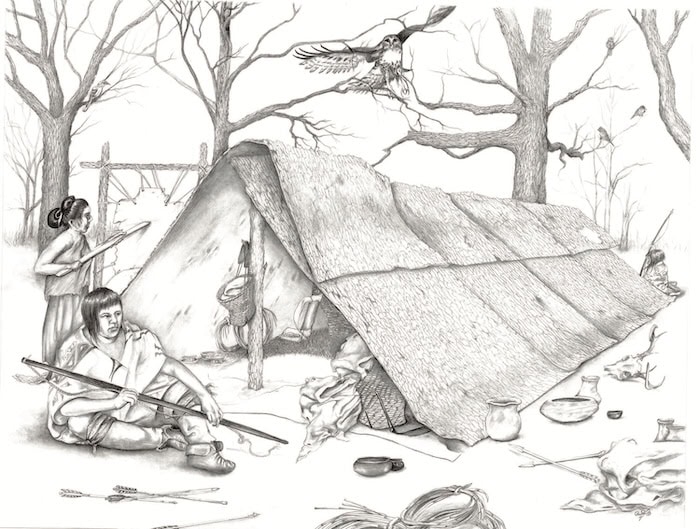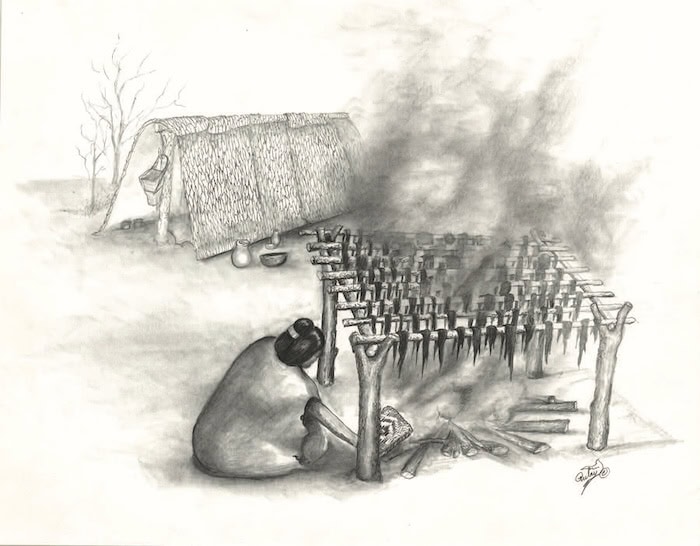
The Big Hunt
Iti FabvssaPublished December 1, 2015Choctaw society developed out of a long and intimate relationship with the plants, animals, soil, and water of our homeland in the southeast. Through this relationship, Choctaw ancestors engineered a food way that minimized their risk of going hungry by relying on a combination of four independent food systems: agriculture, gathering wild plants, fishing, and hunting. This food way was flexible enough to adapt to fluctuating conditions. For example, if it was a bad year for crops or wild plants, Choctaw communities relied more heavily on hunting and fishing to get their sustenance and vice-versa. This month, Iti Fabvssa presents some information about the Choctaw fall and winter hunts.
In the Choctaw calendar, the months after the agricultural fields were harvested are known as Little Hunger Month and Big Hunger Month, roughly corresponding with November and December. This is when Choctaw men would leave the villages on an extended hunting trip known as Owachito (meaning big hunt). The Owachito was so-named because it could last for months, and take hunters over hundreds of miles of territory. Little and Big Hunger Months received their names because Choctaw hunters would take limited, light-weight food rations with them on the Owachito, and because fasting for spiritual purification was an essential part of hunting. It was a hungry time of year.
The regions that Choctaws hunted in the fall and winter changed over the years in connection with changes in the natural and political environment. During the centuries before European contact, most of the ancestral Choctaw population was concentrated in major farming communities located on the central Tombigbee, the central Alabama, and the Black Warrior Rivers and also around Mobile Bay. The neutral ground between these communities was maintained as hunting preserves. In response to European arrival, disease, and slaving raids, Choctaw populations started to reorganize into communities located in what is now eastcentral Mississippi and western Alabama. In the early 1700s, these communities conducted winter hunts in the Tombigbee River valley, the area just north and east of Mobile bay, and also in what is now central Mississippi. Through the 1700s and early 1800s, Choctaw communities and our neighbors, became increasingly involved in the hide trade with European groups. Ultimately deer were hunted at an unsustainable level and became rare in and around the Choctaw homeland. This compelled hunters to travel still farther west on the Owachito. By the 1750s, after making peace with the Chickasaw, if not before, Choctaw hunting parties were traveling as far west as the bank of the Mississippi river. Some of the names given by Choctaw hunters to places in this area are still in use today, including Issaquena (from issi okhina, meaning “deer creek”) and Nita Yuma, probably meaning “bears are there”. By the late 1760s, at the invitation of the Spanish governor, some Choctaw people began moving into what is now Louisiana. By 1800, Choctaw hunting parties were traveling all the way to present-day southern Oklahoma. In fact, the Ouachita mountains may derive their name from the Choctaw term “Owachito”. The familiarity that Choctaw hunters had with the west was demonstrated when, in negotiations for the 1820 treaty of Doak’s Stand, Chief Pushmataha drew out the course of the Canadian River and the upper part of the Red River (between present-day Oklahoma and Texas) for future president Andrew Jackson, whose aides had never been there before. For several decades, Pushmataha and other Choctaw men had been traveling to this area, hunting, encroaching on the territory of the Quapaw, Caddo, and Osage and fighting along the way.
As alluded to above, deer were the main query of Choctaw hunters on the Owachito. The Owachito was not the only time that deer were hunted, but it was the main time. During the fall, deer were to be found in largest numbers in patches of oak/hickory forest, eating fallen nuts and acorns. Later in winter, they moved into dense cane breaks, where they were harder to reach.


After deer, bear were the next-most important Choctaw game animal. More essential than the bear meat itself, was the fat, which was rendered into grease (see Illustration 2). During the 1600s, and up until about 1740, bison herds lived in the heart of the Choctaw homeland, and were regularly hunted. As Choctaw hunters moved west in the 1700s and early 1800s, they continued to hunt small numbers of bison.
From today’s perspective, we only have partial glimpses of what life was like in a Choctaw hunting camp on the Owachito. Able-bodied women may have been present, but primary sources speak of men. We know that parities hunting in distant lands built temporary houses by setting a line of posts in the ground, and then laying sheets of stripped bark from the top of the posts down to the ground on each site. This created an “A” framelike structure. The ends, left open, had camp fires burning near them to keep the occupants warm. (see Illustration 1). Hunting was a spiritual activity. In camp, hunters fasted and prepared themselves to go out and get meat and other products for their community that was depending on them.
We know a little more about the hunting techniques that they used. The surround was an ancient one, whereby hunters went out and encircled herds of deer, sometimes with the use of fire. By the late 1700s, deer were mostly being hunted through stalking. Sometimes, hunters used elaborate decoys made from a stuffed deer head to get close enough to the animals for a good shot. These hunters often walked 30 miles in a day in stalking their query. When a successful hunter brought meat back to camp, it was shared. The kidneys were cut up, distributed, and burned in the hunters’ fires as a way of giving thanks.
Meat was preserved by cutting it into strips and drying it over a smokey fire. Hides were scraped fresh and then dried into rawhide for transport. Fat was taken from the bear and rendered pure in a clay pot over the fire. It was preserved by mixing it with sassafras root chips, and placing it in a pot that had been buried in the cool ground up to its rim. Choctaws probably transported the bear grease in containers made from sewn-up green deer hides. Once emptied, the bags could be un-sewn and, already exposed to the bear grease, would be ready for tanning. When it was time to head back home, hunters would pack up the dried meat and other items on the back of their Choctaw ponies.
Two 50-pound packs would be suspended on each side of the horse, and a third one set on top. For protection from rain, all would be covered by a hide. When a hunting party returned to their village, it was a time of joy and celebration, both because the men had made it home safely, and because of the essential food and materials that they brought with them. Hunters are said to have shared the bounty with their estranged wives and other households that had no one to provide meat. After spending some time in the village, hunters would again go out in the heart of winter in search of animals with prime pelts. This was during Koichito Hvshi and Koichusk Hvshi (Panther Month and Wildcat Month, respectively), which roughly correspond with January and February.
These month names come from two of the animals that were hunted for peltry. Hunters would set up temporary camps , sometimes with their women and children, in places several miles from their village where they could easily access the swamps and cane breaks where peltbearing animals lived during that time of year. Among all of the Southeastern Tribes and European communities, Choctaw men were said to be the best at the dangerous job of hunting panther and bear. Black bear migrated into Choctaw country during late fall, to avoid colder temperatures to the north. Although bear were hunted on the Owachito, this later season hunt was favored by Choctaw hunters because by December the bear were at their fattest and they moved slowly.
In hunting bear, hunters would go out into cane break and look for a rotten, hollow tree showing signs that it was being used as a bear den. They would build a fire at the base of the tree, causing the rotten wood to smolder. Eventually, the bear would be awakened by the smoke and forced to jump from the top of the trunk. Hunters would shoot the bear with arrows in mid-air or on the ground. Choctaw oral stories indicate that hunting dogs were also sometimes used to harass the bear.
The Owachito and the winter pelt hunt were dangerous, but enjoyable times for Choctaw men. The hunts provided them with an opportunity to show their skill and their spiritual efficacy. Through the hunts, they provided their communities not only with animal protein, but also the raw materials such as hides, tendons, antlers, horns, bison wool, glue stock, bones, and hooves that Choctaw people used to make a variety of life-supporting implements, structures, and tools. Today’s Choctaw people who prepare themselves spiritually to go into the woods in November, December, and January, to hunt for meat and other animal products for their families are carrying on a very ancient and storied tribal tradition.